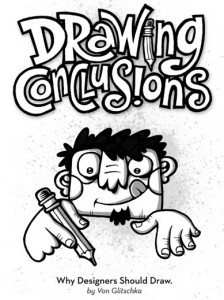Drawing Defined: doodling, sketching – it doesn’t have to be complicated.
Drawing is appropriate creatively because it touched on so many things. Don’t say, “I can’t draw worth crap.” It’s easy to come up with an excuse not to do something. Set those excuses aside. It can fill the gap when the spoken word falls short.
There is a massive history of drawing. From cave drawings to Jesus to Egypt to large land drawings only seen from the air. Monks would even draw in the margins of their work. Comic books have inspired lifetimes of drawers from the 30’s. Commercial art has been around for over 100 years.
Computers have moved things to the “drawing downgrade” and has become a bit of a crutch for drawing. Saul Bass was interviewed in the 90’s and stated that if you don’t know how to draw you are in deep trouble. You gotta be a one man band to start and know the nature of that process. You need all the tools available to think. One of those tools is drawing. “Design is thinking made visual.”
Drawing enhances the narrative and can communicate powerfully.
Drawing today has moved towards a tool-driven process (photoshop or software). Don’t be a “tooler”. Software is just a tool. You need to have a balance between analog and digital skills. Exercise your drawing muscles. Sometime it is difficult because of time or deadlines.
Thumbnailing
Doodles to capture ideas and lock in it’s essence. You can then move forward to refine it. It doesn’t take much but is an easy way to get things out. It allows you to explore ideas quickly.
Images and pictures have better effect and can communicate 6x more effectively than non-visual communications. 75% of your brain sensory processing is dedicated to visual information.
Drawing improves your thinking – doodling in a meeting helps you to remember things better. Drawing enhances learning.
How?
There is no secret to it. Just do it and you will improve. Enjoy the struggle, it won’t be easy at first. For the next 21 days, make drawing a creative habit. Focus on something you like to draw.


